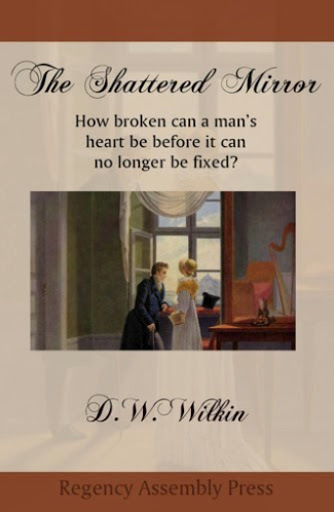D.W. Wilkin's Blog, page 162
December 28, 2014
Space Opera Books Presents Trolling, Trolling, Trolling Fly Hides
Trolling, Trolling, Trolling Fly Hides!
Not only do I write Regency and Romance, but I also have delved into Fantasy.
The Trolling series, (the first three are in print) is the story of a man, Humphrey. We meet him as he has left youth and become a man with a man’s responsibilities.
We follow him in a series of stories that encompass the stages of life. We see him when he starts his family, when he has older sons and the father son dynamic is tested.
We see him when his children begin to marry and have children, and at the end of his life when those he has loved, and those who were his friends proceed him over the threshold into death. All this while he serves a kingdom troubled by monsters.
Troubles that he and his friends will learn to deal with and rectify.
It is now available in a variety of formats. For $2.99 you can get this fantasy adventure.
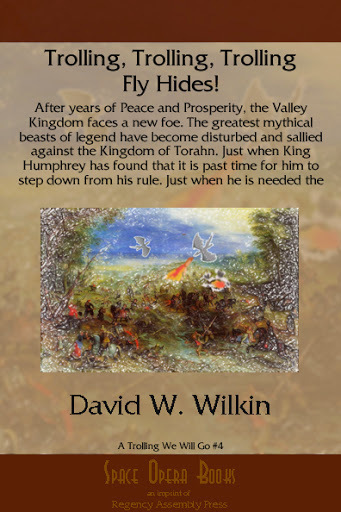
Barnes and Noble for your Nook
Old age is catching up to Humphrey and his friends. He feels it in his bones and with his son and heir having reached the prime of his life, it could very well be time to pass the baton of rule to Daniel.With the Valley Kingdom of Torahn at Peace, that would not be a terrible thing to do. Though breaking his decision to his wife Gwendolyn, the Queen, might be the hardest battle that he ever would fight.
Even as the life of retirement looks to be attractive and possible, however, the Valley Kingdom is beset again. Not Goblins, Trolls, Giants or Men, this time. No. That Humphrey knew would be far too easy.
Those obstacles had been overcome before and the problems they presented had solutions that the army of Torahn was trained to deal with. No, of all the creatures that came forth from Teantellen that they had beaten, the one they had never faced now came forth. Dragons!
Who in the realm knew how to fight these mythical beasts? Was there even away to do so?
Now Humphrey who had thought to spend the remainder of his days quietly writing his memoirs and drinking, was faced with the greatest challenge he had ever known.
Feedback
If you have any commentary, thoughts, ideas about the book (especially if you buy it, read it and like it ;-) then we would love to hear from you.

December 27, 2014
Regency Personalities Series-William Fullarton
Regency Personalities Series
In my attempts to provide us with the details of the Regency, today I continue with one of the many period notables.
William Fullarton
1754–1808
William Fullarton was only son of William Fullarton of Fullarton, a wealthy Ayrshire gentleman. After spending some time at Edinburgh University he was sent to travel on the continent with Patrick Brydone, at one time the travelling tutor of William Beckford, and visited Sicily and Malta. Fullarton was at first intended for the diplomatic service, and was attached as secretary to Lord Stormont’s embassy in Paris; but on his accession to the family estates he went to England and secured his election to parliament for the borough of Plympton Erle in 1779.
In the following year he did not seek re-election, for he had combined a plan of operations which the government accepted. This plan was that he and his intimate friend, Thomas Humberston Mackenzie, should each raise and equip a regiment on their Scottish estates at their own expense, which should be transported in government ships towards the coast of Mexico, in order to wait for and capture the Acapulco fleet. The regiments were accordingly raised, and Fullarton was gazetted lieutenant-colonel-commandant of the 98th regiment on 29 May 1780.
The outbreak of the Fourth Anglo-Dutch War changed the destination of these regiments, which were then ordered to form part of the expedition against the Cape of Good Hope under the command of Commodore George Johnstone and General William Medows. This plan also came to nothing, owing to the arrival of the French admiral, the Bailli de Suffren, at the Cape before the British expedition.
The regiments then went on to India, to take their part in the Second Anglo-Mysore War against Haidar Ali. Mackenzie’s regiment disembarked at Calicut, to make a diversion by invading Mysore from the Malabar coast, while Fullarton’s went round to Madras. He remained in the neighbourhood of the capital of the presidency until after the Battle of Porto Novo, when he was sent south in command of the king’s troops, in order if possible to attract the Mysore troops away from the Carnatic.
In June 1782 Fullarton was gazetted a colonel in the army for the East Indies, with Sir Robert Barker, Norman Macleod, John Floyd, and many others, in order to put an end to the perpetual disputes between the king’s and the company’s officers, and he co-operated in the winter campaign of 1782–3 in the suppression of the Kollars, the fighting tribes of Madura, and in the capture of Karur and Dindigal. Fullarton led the Madras Army against the rebel Kattaboman, a palaiyakarar of Panchalum Kurucchi, a fortress town in present day Tinnevelly District of Tamil Nadu. Fullarton’s name is associated with the destruction of the fort of the rebel chieftain at Nettkelcheval, again in Tinnevelly District. In May 1783 he succeeded to the general command of all the troops south of the Coleroon, and on 2 June he took Dharapuram. He then advanced towards General James Stuart, who was besieging Cuddalore.
On the news of the fall of that city, he determined to attack Pálghát, which had resisted all the efforts of Mackenzie in the previous year. He had to make his way through a dense forest. When he got through it, he had to storm the city. There, he heard that Tippoo Sultan, who had succeeded Haidar Ali on the throne, was not fulfilling the terms agreed to at the surrender of Mangalore, and Fullarton accordingly followed up his success by the capture of the fortress of Coimbatore. At this time, he was imperatively ordered to cease all hostilities by the government of Madras, and a sort of peace was patched up between the company and Tippoo Sahib.
James Mill praised Fullarton as the first Anglo-Indian commander who looked after his commissariat and organised a system for obtaining intelligence of the enemy’s strength and whereabouts. Fullarton returned to England, where he published his polemical tract A View of English Interests in India in 1787. This work, addressed to David Murray, 2nd Earl of Mansfield (previously Lord Stormont), attacked the policies of the East India Company.
He then settled down to a country life, and married Marianne Mackay, daughter of George Mackay, 5th Lord Reay. He took an interest in agricultural questions, and published two memoirs on the state of agriculture in Ayrshire and the advantages of pasture land. He was elected a fellow of the Royal Society of London and Royal Society of Edinburgh. He never again undertook service, but raised the 23rd, or Fullarton’s dragoons, in 1794, and the 101st, or Fullarton’s foot, in 1800, both of the regiments being reduced at the Peace of Amiens in 1802. He continued his parliamentary career, with a low profile, and sat for the Haddington Burghs from 1787 to 1790, for Horsham from 1793 to 1796, and for Ayrshire from 1796 to April 1803.
He was appointed first commissioner for the government of the island of Trinidad. The commission appointed for Trinidad consisted of Fullarton, Captain Samuel Hood of the Royal Navy, and Lieutenant-Colonel Thomas Picton, who had ruled the island since its capture by Sir Ralph Abercromby in 1797. When Fullarton asked for an account of all the criminal proceedings which had taken place in the island since Picton had been there, Picton resigned in disgust. Fullarton persisted in his inquiries, and the result of them was the trial of Picton for inflicting torture on a Spanish girl, Luisa Calderon, to extort a confession from her. This trial caused a public sensation in England. In February 1806, Picton was found guilty. Fullarton was attacked in print by Edward Alured Draper, as was John Sullivan Picton applied for a new trial, at which he was acquitted; but before it started Fullarton died of inflammation of the lungs at Gordon’s Hotel, London, on 13 February 1808. He was buried at Isleworth.

An Unofficial Guide to how to win the Scenarios of Wild the 2nd Expansion for Rollercoaster Tycoon 3
An Unofficial Guide to how to win the Scenarios of Wild
I have been a fan of this series of computer games since early in its release of the very first game. That game was done by one programmer, Chris Sawyer, and it was the first I recall of an internet hit. Websites were put up in dedication to this game where people showed off their creations, based on real amusement parks. These sites were funded by individuals, an expense that was not necessarily as cheap then as it is now. Nor as easy to program then as it might be to build a web page now.
Prima Books released game guides for each iteration of the game, Rollercoaster Tycoon 1, Rollercoaster Tycoon 2 and Rollercoaster Tycoon 3 (RCT3) but not for the expansion sets. And unlike the first two works, the third guide was riddle with incorrect solutions. As I played the game that frustrated me. And I took to the forums that Atari, the game publisher hosted to see if I could find a way to solve those scenarios that the Prima Guide had written up in error. Not finding any good advice, I created my own for the scenarios that the “Official” Guide had gotten wrong.
Solutions that if you followed my advice you would win the scenario and move on. But if you followed the “Official” version you would fail and not be able to complete the game. My style and format being different than the folks at Prima, I continued for all the Scenarios that they had gotten right as well, though my solutions cut to the chase and got you to the winner’s circle more quickly, more directly.
My contributions to the “Official” Forum, got me a place as a playtester for both expansions to the game, Soaked and Wild. And for each of these games, I wrote the guides during the play testing phase so all the play testers could solve the scenarios, and then once again after the official release to make changes in the formula in case our aiding to perfect the game had changed matters. For this, Atari and Frontier (the actual programmers of the game) placed me within the game itself.
And for the longest time, these have been free at the “Official” Forums, as well as my own website dedicated to the game. But a short time ago, I noticed that Atari, after one of its bankruptcies had deleted their forums. So now I am releasing the Guide for one and all. I have added new material and it is near 100 pages, just for the first of the three games. It is available for the Kindle at present for $2.99.
(Click on the picture to purchase)
Not only are all 12 Scenarios covered, but there are sections covering every Cheat Code, Custom Scenery, the famous Small Park Competition, the Advanced Fireworks Editor, the Flying Camera Route Editor which are all the techniques every amusement park designer needs to make a fantastic park in Rollercoaster Tycoon 3.

December 26, 2014
Regency Personalities Series-Charles Sackville-Germain 5th Duke of Dorset
Regency Personalities Series
In my attempts to provide us with the details of the Regency, today I continue with one of the many period notables.
Charles Sackville-Germain 5th Duke of Dorset
27 August 1767 – 29 July 1843
Charles Sackville-Germain 5th Duke of Dorset was known briefly as Charles Sackville before 1770, as The Hon. Charles Germain between 1770 and 1785, and as The Viscount Sackville between 1785 and 1815, was a British peer, courtier and Tory politician. He served as Master of the Horse between 1821 and 1827 and again briefly in 1835.
Born Charles Sackville, he was the eldest son of Lord George Sackville. His father changed the family surname to Germain in 1770 and was created Viscount Sackville in 1782. Dorset re-incorporated the former surname as a double-barrelled one later in life.
Dorset succeeded his father in the viscountcy in 1785. In 1815 he also succeeded his cousin in the dukedom of Dorset. In 1821 he was sworn of the Privy Council and appointed Master of the Horse under Lord Liverpool. Serving in that office until 1827 and again briefly under Sir Robert Peel from January to April 1835, he was also appointed a Knight of the Garter in 1826.
Dorset died unmarried and childless in 1843 and all of his titles became extinct. His memorial is in St Peter’s Church, Lowick, Northamptonshire. It comprises a white marble chest-tomb by Richard Westmacott and has a draped mantle, shield and coronet with a human sized angel seated alongside.

Fantasy from Space Opera Books, Trolling’s Pass and Present
Trolling’s Pass and Present
Not only do I write Regency and Romance, but I also have delved into Fantasy. The Trolling series, (the first three are in print) is the story of a man, Humphrey.
We meet him as he has left youth and become a man with a man’s responsibilities. We follow him in a series of stories that encompass the stages of life.
We see him when he starts his family, when he has older sons and the father son dynamic is tested. We see him when his children begin to marry and have children, and at the end of his life when those he has loved, and those who were his friends proceed him over the threshold into death.
All this while he serves a kingdom troubled by monsters. Troubles that he and his friends will learn to deal with and rectify.
It is now available in a variety of formats. For $2.99 you can get this fantasy adventure.
Barnes and Noble for your Nook
Years since their battles with the Trolls, even on foreign soil, the warriors of the Valley Kingdom of Torahn need something to keep their edge honed.
The economy too is beginning to fray a little without the great wars to support. The Leaders hit upon the idea of searching for a path to reach the east side of the continent.
The Elves swear that at one time their writings tell of such, the Dwarves swear such a pass across Teantellen is legendary. Teantellen though is filled with races man has never gotten along with well. Goblins, Dark Elves, Trolls, Giants and Dragons.
It has been years since the mountain tops exploded, and perhaps that has changed things enough that a way can be found to link the western lands with the eastern lands and increase trade, and prosperity for all. Even should they fail in their quest, as the history of man has shown to this point in time, the attempt will do much to spur the economy.
Tens of thousands of gold will be spent by the Council of Twenty-One to pay for such an expedition. Gold that those who are not so scrupulous might choose to pocket as they tried in the Troll Wars.
With such shenanigans taking place again, are the hopes of the previous generation, the leaders from the Troll Wars now in retirement, ready to be achieved? Is it time for Torahn, called the Valley Kingdom, but the only Kingdom without a King, to have a King once more?
Feedback
If you have any commentary, thoughts, ideas about the book (especially if you buy it, read it and like it ;-) then we would love to hear from you.

December 25, 2014
Regency Personalities Series-Queen Victoria
Regency Personalities Series
In my attempts to provide us with the details of the Regency, today I continue with one of the many period notables.
Queen Victoria
24 May 1819 – 22 January 1901
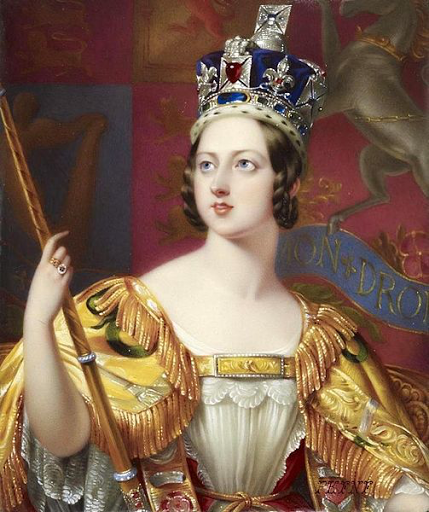
Victoria
Queen Victoria ‘s father was Prince Edward, Duke of Kent and Strathearn, the fourth son of the reigning King of the United Kingdom, George III. Until 1817, Edward’s niece, Princess Charlotte of Wales, was the only legitimate grandchild of George III. Her death in 1817 precipitated a succession crisis in the United Kingdom that brought pressure on the Duke of Kent and his unmarried brothers to marry and have children. In 1818, he married Princess Victoria of Saxe-Coburg-Saalfeld, a widowed German princess who already had two children—Carl (1804–1856) and Feodora (1807–1872)—by her first marriage to the Prince of Leiningen. Her brother Leopold was the widower of Princess Charlotte. The Duke and Duchess of Kent’s only child, Victoria, was born at 4.15 a.m. on 24 May 1819 at Kensington Palace in London.
Victoria was christened privately by the Archbishop of Canterbury, Charles Manners-Sutton, on 24 June 1819 in the Cupola Room at Kensington Palace. She was baptised Alexandrina, after one of her godparents, Emperor Alexander I of Russia, and Victoria after her mother. Additional names proposed by her parents—Georgina (or Georgiana), Charlotte and Augusta—were dropped on the instructions of the Duke’s elder brother, the Prince Regent.
At birth, Victoria was fifth in the line of succession after her father and his three older brothers: the Prince Regent, the Duke of York, and the Duke of Clarence (later William IV). The Prince Regent and the Duke of York were estranged from their wives, who were both past child-bearing age, so the two eldest brothers were unlikely to have any further children. The Dukes of Kent and Clarence married on the same day 12 months before Victoria’s birth, but both of Clarence’s daughters (born in 1819 and 1820 respectively) died as infants. Victoria’s grandfather and father died in 1820, within a week of each other, and the Duke of York died in 1827. On the death of her uncle George IV in 1830, Victoria became heiress presumptive to her next surviving uncle, William IV. The Regency Act 1830 made special provision for the Duchess of Kent to act as regent in case William died while Victoria was still a minor. King William distrusted the Duchess’s capacity to be regent, and in 1836 declared in her presence that he wanted to live until Victoria’s 18th birthday, so that a regency could be avoided.
Victoria later described her childhood as “rather melancholy”. Her mother was extremely protective, and Victoria was raised largely isolated from other children under the so-called “Kensington System”, an elaborate set of rules and protocols devised by the Duchess and her ambitious and domineering comptroller, Sir John Conroy, who was rumoured to be the Duchess’s lover. The system prevented the princess from meeting people whom her mother and Conroy deemed undesirable (including most of her father’s family), and was designed to render her weak and dependent upon them. The Duchess avoided the court because she was scandalised by the presence of the King’s bastard children, and perhaps prompted the emergence of Victorian morality by insisting that her daughter avoid any appearance of sexual impropriety. Victoria shared a bedroom with her mother every night, studied with private tutors to a regular timetable, and spent her play-hours with her dolls and her King Charles spaniel, Dash. Her lessons included French, German, Italian, and Latin, but she spoke only English at home.
In 1830, the Duchess of Kent and Conroy took Victoria across the centre of England to visit the Malvern Hills, stopping at towns and great country houses along the way. Similar journeys to other parts of England and Wales were taken in 1832, 1833, 1834 and 1835. To King William’s annoyance, Victoria was enthusiastically welcomed in each of the stops. William compared the journeys to royal progresses and was concerned that they portrayed Victoria as his rival rather than his heiress presumptive. Victoria disliked the trips; the constant round of public appearances made her tired and ill, and there was little time for her to rest. She objected on the grounds of the King’s disapproval, but her mother dismissed his complaints as motivated by jealousy, and forced Victoria to continue the tours. At Ramsgate in October 1835, Victoria contracted a severe fever, which Conroy initially dismissed as a childish pretence. While Victoria was ill, Conroy and the Duchess unsuccessfully badgered her to make Conroy her private secretary. As a teenager, Victoria resisted persistent attempts by her mother and Conroy to appoint him to her staff. Once queen, she banned him from her presence, but he remained in her mother’s household.
By 1836, the Duchess’s brother, Leopold, who had been King of the Belgians since 1831, hoped to marry his niece to his nephew, Prince Albert of Saxe-Coburg and Gotha. Leopold, Victoria’s mother, and Albert’s father (Ernest I, Duke of Saxe-Coburg and Gotha) were siblings. Leopold arranged for Victoria’s mother to invite her Coburg relatives to visit her in May 1836, with the purpose of introducing Victoria to Albert. William IV, however, disapproved of any match with the Coburgs, and instead favoured the suit of Prince Alexander of the Netherlands, second son of the Prince of Orange. Victoria was aware of the various matrimonial plans and critically appraised a parade of eligible princes. According to her diary, she enjoyed Albert’s company from the beginning. After the visit she wrote, “[Albert] is extremely handsome; his hair is about the same colour as mine; his eyes are large and blue, and he has a beautiful nose and a very sweet mouth with fine teeth; but the charm of his countenance is his expression, which is most delightful.” Alexander, on the other hand, was “very plain”.
Victoria wrote to her uncle Leopold, whom Victoria considered her “best and kindest adviser”, to thank him “for the prospect of great happiness you have contributed to give me, in the person of dear Albert … He possesses every quality that could be desired to render me perfectly happy. He is so sensible, so kind, and so good, and so amiable too. He has besides the most pleasing and delightful exterior and appearance you can possibly see.” However at 17, Victoria, though interested in Albert, was not yet ready to marry. The parties did not undertake a formal engagement, but assumed that the match would take place in due time.
Victoria turned 18 on 24 May 1837, and a regency was avoided. On 20 June 1837, William IV died at the age of 71, and Victoria became Queen of the United Kingdom. In her diary she wrote, “I was awoke at 6 o’clock by Mamma, who told me the Archbishop of Canterbury and Lord Conyngham were here and wished to see me. I got out of bed and went into my sitting-room (only in my dressing gown) and alone, and saw them. Lord Conyngham then acquainted me that my poor Uncle, the King, was no more, and had expired at 12 minutes past 2 this morning, and consequently that I am Queen.” Official documents prepared on the first day of her reign described her as Alexandrina Victoria, but the first name was withdrawn at her own wish and not used again.
Since 1714, Britain had shared a monarch with Hanover in Germany, but under Salic law women were excluded from the Hanoverian succession. While Victoria inherited all the British dominions, Hanover passed instead to her father’s younger brother, her unpopular uncle the Duke of Cumberland and Teviotdale, who became King Ernest Augustus I of Hanover. He was her heir presumptive until she married and had a child.
At the time of her accession, the government was led by the Whig prime minister Lord Melbourne, who at once became a powerful influence on the politically inexperienced Queen, who relied on him for advice. Charles Greville supposed that the widowed and childless Melbourne was “passionately fond of her as he might be of his daughter if he had one”, and Victoria probably saw him as a father figure. Her coronation took place on 28 June 1838, and she became the first sovereign to take up residence at Buckingham Palace. She inherited the revenues of the duchies of Lancaster and Cornwall, and was granted a civil list of £385,000 per year. Financially prudent, she paid off her father’s debts.
(DWW-Her Coronation marks the end of the Regency Era and the start of the Victorian Era, with so many accomplishments the amount of information would be many more times what is displayed here.)

RAP has The Shattered Mirror, A Regency Romance
The Shattered Mirror
For your enjoyment, one of the Regency Romances I published. It is available for sale and now at a reduced price, and I hope that you will take the opportunity to order your copy.
Order for yourself or as a gift. It is now available in a variety of formats. For just a few dollars this Regency Romance can be yours for your eReaders or physically in Trade Paperback.
Barnes and Noble for your Nook
and in Trade Paperback
Bridget Halifax-Stokes was giddy with the excitement of her season in London. Town had beckoned and her season came on the heels of the end of the war against the tyrant.
All the handsome men were returning heroes. What better year to come out.
Her father thought it all nonsense. Her mother believed that it would be the best showing of any of her daughters.
More lords available and luck that Bridget was just the perfect age.
All is fun and frivolity until Bridget literally crashes into Sir Patrick Hampton as he limps along the high street. A man she knew once well, now a stranger with dark and foreboding eyes.
Feedback
If you have any commentary, thoughts, ideas about the book (especially if you buy it, read it and like it ;-) then we would love to hear from you.

December 24, 2014
Regency Personalities Series-Princess Amelia of the United Kingdom
Regency Personalities Series
In my attempts to provide us with the details of the Regency, today I continue with one of the many period notables.
Princess Amelia of the United Kingdom
7 August 1783 – 2 November 1810
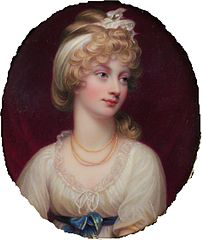
Princess Amelia
Princess Amelia of the United Kingdom was born on 7 August 1783, at the Royal Lodge, Windsor, the youngest of George III and Queen Charlotte’s fifteen children as well as the only of her siblings born at Windsor Castle. It is often said that she was her father’s favourite, and accordingly, he affectionately called her, “Emily”. She was born after the early deaths of her two elder brothers: Octavius (23 February 1779 – 3 May 1783) and Alfred (22 September 1780 – 20 August 1782). The death of these two princes left a gap of almost six years between Amelia and her nearest surviving sibling, Princess Sophia. She was twenty-one years younger than her eldest sibling George and nearly seventeen years younger than her eldest sister Charlotte. As the daughter of the monarch, she was styled Her Royal Highness The Princess Amelia from birth.
Amelia was christened at the Chapel Royal, St James’s Palace by John Moore, The Archbishop of Canterbury, on 17 September 1783. Her godparents were The Prince of Wales (Amelia’s eldest brother), The Princess Royal (her eldest sister), and The Princess Augusta Sophia (her second eldest sister). She was the fifteenth sibling christened there.
Coming so soon after the death of Octavius and shortly before the end of the war between Great Britain and the United States, Amelia’s birth was felt to be a beginning of a new period of hope, and much was expected of her, even from birth. “Our littlest sister is without exception one of the prettiest children I have ever seen,” her oldest sister wrote to Prince William when Amelia was only a month old. She was expected to be as beautiful, charming, and winning as Octavius, her father’s previous favorite child, had been. As a result of her two brothers’ deaths, Amelia was considered as her father’s favourite.
From an early age, Amelia was conscious of her rank. A popular tale relates that when the famous tragedian, Sarah Siddons, expressed a desire to kiss the beautiful baby, Amelia “…instantly held her little hand out to be kissed, so early had she learnt the lessons of Royalty.” When Amelia was three, Fanny Burney, the Queen’s Keeper of the Robes, commented that the princess could be “decorous and dignified when called upon to act en princess to any strangers, as if conscious of her high rank, and the importance of condescendingly sustaining it.” Burney even dubbed her “the little idol”. As the youngest of the thirteen surviving children, Amelia was grouped with her sisters Mary and Sophia, and spent most of her time with them, living in various royal residences. From the beginning, the three younger princesses did not receive as much parental attention as their elder sisters had, and spent a good deal of time away from the King and Queen, communicating with them mostly by letter.
It seems that the three youngest princesses were much wilder than their elder sisters, as evidenced by their behavior when they sat for a portrait in 1785. In 1770, Zoffany had been able to paint the King, the Queen, and all six eldest children with little difficulty. In 1785, however, Copley had so much difficulty getting the dogs, birds, and especially the three royal children to sit still, that he never painted another portrait. Compared to the carefully planned education that Charlotte, Augusta, and Elizabeth had been given, the education given to Mary, Sophia, and Amelia was based solely on what had come before. Amelia was only five years old when her father suffered his first bout of madness. As a consequence of her father’s declining health, she never experienced the closeness and affection that had characterized the family during her elder sisters’ early years.
Prior to 1788, King George had told his daughters that he would take them to Hanover and find them suitable husbands despite misgivings he had, which stemmed from his sisters’ own unhappy marriages. He remarked, “I cannot deny that I have never wished to see any of them marry: I am happy in their company, and do not in the least want a separation.” However, the King suffered his first bout of madness that year, when Amelia was aged five. Further lapses into insanity occurred in 1801 and 1804, thus forestalling talk of marriage for his daughters. The question of matrimony was rarely raised; Queen Charlotte feared that the subject, which had always discomforted the King, would push him back into insanity. Furthermore the queen, strained from her husband’s illness, wanted the princesses to remain close to her.
Amelia and her sisters, Charlotte, Augusta Sophia, Elizabeth, Mary and Sophia were over-protected and isolated, which restricted them meeting eligible suitors of their own age.
In 1798 Princess Amelia developed a pain in the joint of her knee, and was sent to the large seaside town of Worthing for recovery. She wrote to her father, “Certainly the vapour and warm sea bath are of use and therefore I hope that I shall be able to assure you that I am better.” The following year Amelia temporarily recovered enough to join her family at Weymouth, where she doted upon her niece Princess Charlotte of Wales. Throughout her life Amelia was often in poor health; at the age of fifteen, she started to suffer the early symptoms of what turned out to be tuberculosis.
In 1801 the princess was sent for a seaside cure at Weymouth to improve her health. Among those staying with her was the Hon. Charles FitzRoy, an equerry 21 years older than herself, and the son of Charles FitzRoy, 1st Baron Southampton. Amelia fell in love with the equerry, desiring to marry him. The Queen was told of the affair by a servant, but turned a blind eye. It was hoped that such discretion would prevent the King from discovering the liaison, which may have risked sending him into one of the bouts of mental illness to which he was becoming increasingly prone. Though she never gave up hope of marrying him, Amelia knew she could not legally marry FitzRoy due to the provisions of the Royal Marriages Act passed by her father’s Parliament (at least until she reached the age of 25, after which she could receive permission by assent of the Privy Council). She would later tell her brother Frederick that she considered herself to be married, taking the initials A. F. R. (Amelia FitzRoy).
In 1808, Amelia had a severe attack of measles and the depressed atmosphere at home with her mother in Windsor made her even more miserable. The anxious King George decided to send Amelia to Weymouth accompanied by her sister Mary. Her health was improved only a little, but she found comfort in quietly resting. In 1809 she could occasionally take short walks in the garden. This improvement was but temporary, however, and in August 1810 her sufferings grew sharper, whilst in October of that year she was seized with St. Anthony’s fire (erysipelas), which cut off all hope and confined her to her bed on the 25th. The king summoned his daughter’s physicians to him at seven o’clock every morning and three or four other times during the day, questioning them minutely as to her condition. She lingered a few days more, waited upon to the last by her favourite and devoted sister, the Princess Mary, Duchess of Gloucester and Edinburgh. Her 2 November death occurred on her brother Edward’s birthday.
The dying princess had a mourning ring made for the king, composed of a lock of her hair, under crystal, set round with diamonds. He purportedly burst into tears upon receiving it. Otherwise, her will dictated all her possessions be given to Charles FitzRoy. Amelia was buried in the royal vault in St George’s Chapel, Windsor. Her eldest brother, later George IV, was her godfather and is reputed to have requested her death mask.
After Amelia’s death, George Villiers, the King’s bailiff, and younger brother of Thomas Villiers, 2nd Earl of Clarendon, attempted to blackmail the King and Queen with letters belonging to Amelia, after the disappearance of £280,000 in his control. Villiers was father of later diplomat and statesman George Villiers, 4th Earl of Clarendon.
Her death is partly credited to the decline in her father’s health which resulted in his insanity and the subsequent invocation of the Regency Act of 1811. According to his doctor Dr. Willis, the king would later cry “in a wild, monotonous, delirious way, ‘Oh Emily [Princess Amelia], why won’t you save your father? I hate all the physicians…” Another of King George’s delusions included the belief that a healthy Amelia was only staying in Hanover with a large family of her own, where she would “never grow older and always be well.”
Amelia has been described as a beautiful, slender girl with ruby lips and auburn hair. Reportedly she was the “most turbulent and tempestuous of all the Princesses”. However, she is also said to have been gentle, unselfish and highly intelligent. These qualities led her sister-in-law Princess Caroline, who was known to despise her in-laws, to call Amelia the “most amiable of the bunch”. Amelia was a favorite of both the Prince of Wales and the Duke of Sussex, who called her a “lovely creature”. Amelia adored the former and once told him that she had always loved him better than her other brothers. He for his part loved her perhaps more than he did his other sisters (with the possible exception of Princess Mary) and was devastated when she died. So deeply affected was he by her death that after her funeral, he could never again sleep in a room that was not lit by several wax candles. He also burst into tears at the mention of her name more than three years after her demise.

Trolling Down to Old Mah Wee, another Fantasy
Trolling Down to Old Mah Wee
Not only do I write Regency and Romance, but I also have delved into Fantasy.
The Trolling series, (the first three are in print) is the story of a man, Humphrey. We meet him as he has left youth and become a man with a man’s responsibilities. We follow him in a series of stories that encompass the stages of life.
We see him when he starts his family, when he has older sons and the father son dynamic is tested. We see him when his children begin to marry and have children, and at the end of his life when those he has loved, and those who were his friends proceed him over the threshold into death.
All this while he serves a kingdom troubled by monsters. Troubles that he and his friends will learn to deal with and rectify. It is now available in a variety of formats.
For $2.99 you can get this 2nd book in the fantasy adventure series of Humphrey and Gwendolyn.
Barnes and Noble for your Nook
When the neighboring kingdom of Mah Wee begins to experience the same problems that beset Torahn some years before, they urgently request the aid of the experts in containing a new Troll infestation. But eradicating Trolls is not as easy as exterminating a few rats or mice.
Trolls are bigger than men, they are stronger than men, and then are meaner than men. Humphrey Cutter and his band of mismatched warriors must once again rise to the occasion, but can they without the aid of expertise of Gwendolyn and her particular skills?
Mah Wee, an ancient kingdom, with a monarch more steeped in the rights of being a king rather than the obligations and duties that a king should be. Here Humphrey and his crew finds that they have more than Trolls to overcome if they are to save Mah Wee from the same or nearly similar problems that they faced before in Torahn.
But, as Humphrey knows, nothing can truly be accomplished if the lovely Gwendolyn is not able to lend her aid as well.
Feedback
If you have any commentary, thoughts, ideas about the book (especially if you buy it, read it and like it ;-) then we would love to hear from you.

December 23, 2014
Regency Personalities Series-Daniel Terry
Regency Personalities Series
In my attempts to provide us with the details of the Regency, today I continue with one of the many period notables.
Daniel Terry
1780?–1829
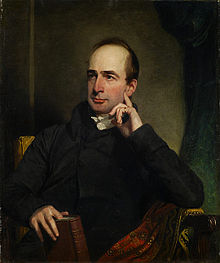
Daniel Terry
Daniel Terry was born in Bath about 1780, and was educated at the Bath grammar school and subsequently at a private school at Wingfield (?Winkfield), Wiltshire, under the Rev. Edward Spencer. During five years he was then a pupil of Samuel Wyatt, the architect.
Having first played at Bath Heartwell in the Prize, Terry left Wyatt to join (in 1803 to 1805) the company at Sheffield under the management of William Macready the Elder. His first appearance was as Tressel in Richard III and was followed by other parts, Thomas Cromwell in Henry VIII and Edmund in King Lear. Towards the close of 1805 he joined Stephen Kemble in the north of England.
On the breaking up in 1806 of Kemble’s company, he went to Liverpool and made a success which recommended him to Henry Siddons, who brought him out in Edinburgh, 29 November 1809, as Bertrand in William Dimond’s Foundling of the Forest. On 12 December he was Antigonus in The Winter’s Tale, on 8 January 1810 Prospero, and on the 29th Argyle in Joanna Baillie’s Family Legend. Walter Scott, à propos of this role, wrote: ‘A Mr. Terry, who promises to be a fine performer, went through the part of the old earl with great taste and effect.’ Scott also contributed a prologue which Terry spoke.
He was Lord Ogleby in the Clandestine Marriage, 18 November 1810 in Edinburgh. In this part Terry made his first appearance in London at the Haymarket, 20 May 1812. He created some original characters in lesser plays, including Count Salerno in Eyre’s Look at Home, 15 August 1812, based on John Moore’s Zeluco. He was announced to reopen, 14 November, the Edinburgh theatre as Lord Ogleby, but was ill and did not appear until the 23rd, and on the 24th he played Shylock. He was on 23 December the first Lord Archibald in Caledonia, or the Thistle and the Rose.
On 8 September 1813, as Leon in Rule a Wife and Have a Wife by John Fletcher, Terry made his first appearance at Covent Garden, where, with frequent migrations to Edinburgh and summer seasons at the Haymarket, he remained until 1822. Among the parts he played in his first season were Sir Robert Bramble in the Poor Gentleman, Dornton in the Road to Ruin, Ford, Sir Adam Contest in the Wedding Day, Ventidius in Antony and Cleopatra, Shylock, Churlton, an original part in James Kenney’s Debtor and Creditor, 26 April 1814, and Sir Oliver in ‘School for Scandal.’
On 12 March 1816 Guy Mannering, a musical adaptation by Terry of Scott’s novel, was seen for the first time. This appears to have been the first of Terry’s adaptations from Scott. At the Haymarket he was seen as Periwinkle in A Bold Stroke for a Wife. In 1815, meanwhile, he had, by permission of the Covent Garden management, supported Sarah Siddons in her farewell engagement in Edinburgh, where he played Macbeth, ‘The Stranger’ [sic] in Douglas, Wolsey, King John, and the Earl of Warwick. Back at Covent Garden, he was, 7 October 1816, the original Colonel Rigolio in William Dimond’s Broken Sword, and on 12 November the original Governor of Surinam in Morton’s Slave.
On 2 October 1817 his acting of Frederick William, King of Prussia, in William Abbot’s Youthful Days of Frederick the Great, raised his reputation to the highest point it attained, and on 22 April 1818 he was the first Salerno in Richard Lalor Sheil’s Bellamira.’ In Jameson’s Nine Points of the Law he was at the Haymarket, 17 July, Mr. Precise, and in the ‘Green Man,’ 15 August, exhibited what was called a perfect piece of acting as Mr. Green. At Covent Garden he was, 17 April 1819, the first David Deans in his own adaptation, The Heart of Midlothian; played Sir Sampson Legend in Love for Love, Buckingham in Richard III, Prospero, Sir Amias Paulet in Mary Stuart (adapted from Schiller), 14 December 1819, Lord Glenallan, and afterwards was announced for Jonathan Oldbuck in his own and Isaac Pocock’s adaptation, The Antiquary, 25 January 1820. Illness seems to have prevented his playing Oldbuck, which was assigned to John Liston.
On 17 May he was the first Dentatus in Sheridan Knowles’s Virginius. At the Haymarket during the summer seasons Terry played a great round of comic characters. Among many original parts in pieces by James Kenney, J. Dibdin, and others, Terry was Sir Christopher Cranberry in Exchange no Robbery, by his friend Theodore Hook, 12 August 1820; the Prince in Match Breaking, 20 August 1821; and Shark in Morning, Noon, and Night, 9 September 1822.
Having quarrelled with the management of Covent Garden on a question of terms, Terry made his first appearance at Drury Lane, 16 October 1822, speaking an occasional address by Colman and playing Sir Peter. At the Haymarket, 7 July, he was the first Admiral Franklin in James Kenney’s Sweethearts and Wives, and on 27 September the first Dr. Primrose in a new adaptation by T. Dibdin of the Vicar of Wakefield.
The season 1823–4 at Drury Lane saw him as Bartolo in Fazio, Lord Sands, Menenius in Coriolanus, and as the first Antony Foster in a version of Kenilworth, 5 January 1824, and the following season as Orozembo in Pizarro, Justice Woodcock in Love in a Village, Adam in As you like it, Moustache in Henri Quatre, Hubert in King John, and Rochfort in an alteration of the Fatal Dowry. Among his original rôles were Zamet in Massaniello, 17 February 1825, and Mephistopheles in Dr. Faustus, 16 May.
In 1825, in association with his friend Frederick Henry Yates, he became manager of the Adelphi, opening, 10 October, in a piece called Killigrew. On the 31st was produced Edward Fitzball’s adaptation, The Pilot, in which Terry was the Pilot. He also appeared in other parts. But he shortly left management because of outside troubles.
Scott consulted Terry on literary questions, especially on plays, and seems to have trusted him with the Doom of Devorgoil, with a view to adapting it for the stage. How many of the numerous stage adaptations of Scott that saw the light between the appearance of Waverley and the death of the actor are by Terry cannot be said, many of them being anonymous and unprinted. Terry was almost as well known in Edinburgh as in London, and Scott thought highly of his acting. Terry’s idolatry of Scott led him to imitate both his manner and his calligraphy. He also took off Scott’s speech, so as almost to pass for a Scotsman. Scott lent him money for his theatrical speculations, and gave him advice.
Terry’s architectural knowledge was of use to Scott, who consulted him while building Abbotsford; the introduction to Edward Blore was from him. Terry was responsible also for the British Theatrical Gallery, a collection of whole-length portraits with biographical notes (London, 1825)
Being intimate with the Ballantynes, Scott’s publishers, Terry took a financial stake in their business, and when their business crash came Scott was saddled with his liability (£1,750). Terry’s financial affairs became so involved that he was obliged to retire from management, and he suffered a breakdown.
After leaving the Adelphi he temporarily retired to the continent, and then re-engaged at Drury Lane and played Polonius and Simpson. Finding himself unable to act, and his memory gone, he gave up his engagement.
On 12 June 1829 he was struck with paralysis, and died during the month.
Having first married in Liverpool, Terry took as his second wife Elizabeth Nasmyth, the daughter of Alexander Nasmyth the painter. Mrs. Terry—who, after Terry’s death, married Charles Richardson the lexicographer—had good taste in design, and seems to have taken a share in the decoration of Abbotsford. Terry left by her a son named after Scott (Walter), after whose fortunes Scott promised to look, and a daughter Jane.




